Everything discussed in the first part of my series will lay the foundation for each subsequent coverage. If you have not read it, I encourage you to do so here.
With that in mind, let us take a look at the Cover 1 defense, a defense that shows up quite commonly on Sundays, whether you realized it or not. It is an extremely basic defense that gets its name from the fact that there is one deep defender to cover the deep zone and plays man across the board on all receivers.
Below is a play against the Tennessee Titans in Week 6. The Titans face 1st and 10 from the Ravens 37 yard line. The score is 14-0 with the Ravens leading 9:38 left in the second quarter.
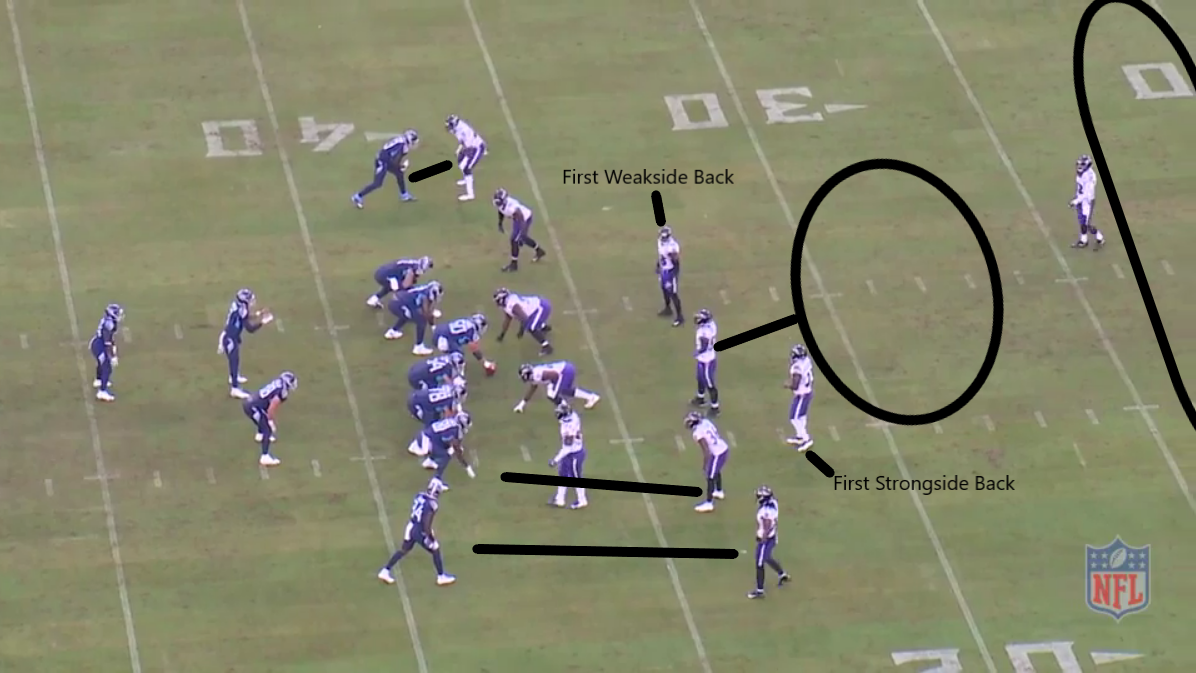
As stated above, Cover 1 is man coverage across the board with a single deep safety to cover a single deep zone. Eric Weddle is the free safety over the top. Underneath, Brandon Carr and Jimmy Smith will man up against their wide receivers. The strong safety, Chuck Clark on this play, will play the strong side and cover the tight end.
The role of the linebackers is a little more fluid. The SAM linebacker, the linebacker playing on the strong-side of the formation where the tight end is, will pick up the first running back to run a route to his side of the formation. The WILL linebacker, the linebacker player on the weak-side of the formation where there is no tight end, will pick up the first back to run a route to his side of the formation. The MIKE, the middle linebacker, will then either drop into a zone to cover the middle of the field on all underneath and crossing routes or blitz.
But wait, what if both backs run a route to the strong-side or the weak-side of the formation? Then the SAM or WILL is left running across the formation, through traffic, and this creates problems, right? You would think so, but this is why I said the roles are slightly fluid. In actuality, what happens is that the MIKE linebacker will pick up the second back and the WILL or SAM, whoever did not have a route run to their side of the formation, will then play the role of dropping into the middle zone or blitz.
I have another question, though. What if neither or only one of the backs runs a route? What if one or both stay into block? Again, this is why I said the roles of the linebackers are a little fluid. The linebackers now have not one, but two choices. The linebackers can all drop into underneath routes and squat on any crossing quick inside breaking routes or the linebackers can execute what is called a "green dog blitz." A green dog blitz is when the linebackers read that their man is blocking and then blitz in response to having no man to cover. It is not a designed blitz, but rather a function of the play calling. Or, they could have the best of both worlds and squat on any crossing routes until they are sure that the receivers will not cross into their zone, then blitz.
Quite frankly, as long as every single offensive player that is running a route is covered, the linebackers offer a great deal of flexibility in how they are used.
Let us see how this play unfolds:
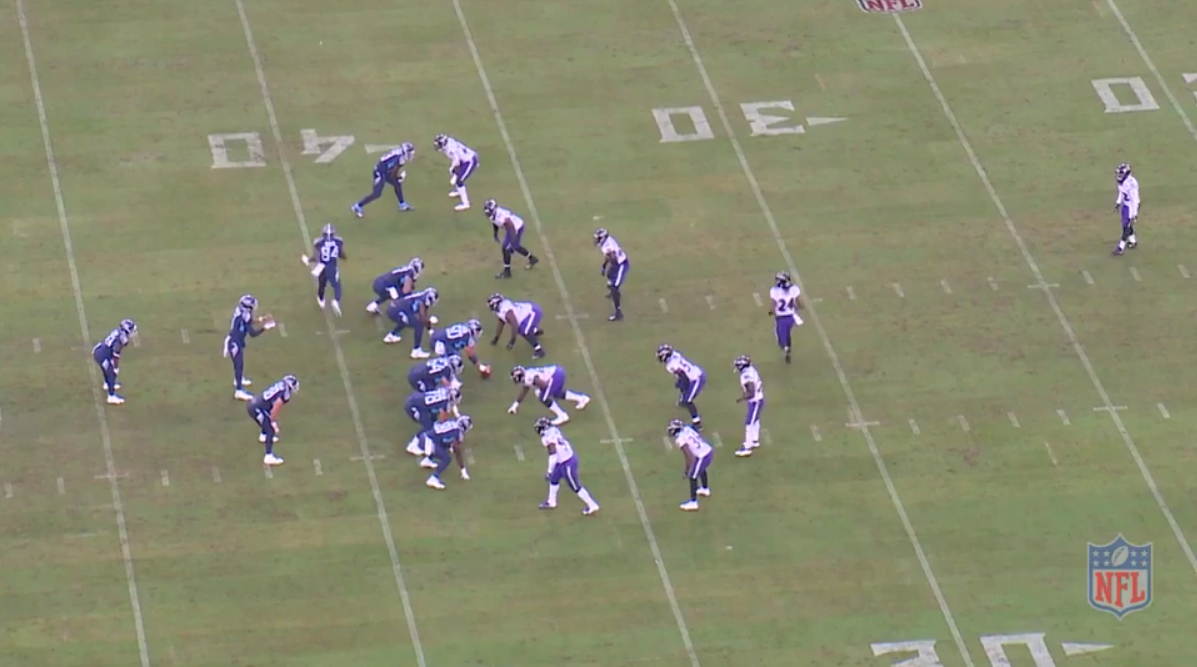
The Tennessee Titans send a wide receiver in motion. Brandon Carr follows across the formation. This instantly signals two things to the Titans. 1. The Ravens are playing man coverage and 2. Based on presnap alignment, the Ravens are playing Cover 1.
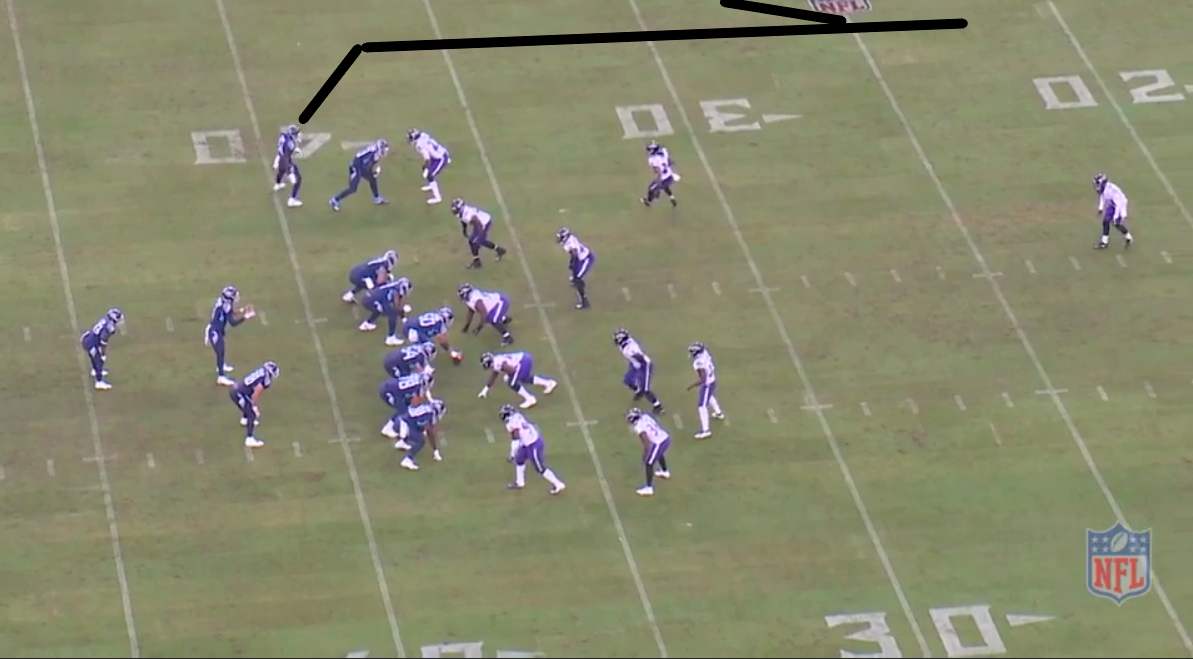
With the Titans settling into a stacked formation, Jimmy Smith motions with his arm that if the outside wide receiver releases outside, Smith will follow and pin him to the sideline. Pinning the wide receiver to the sideline gives the wide receiver access to only two "easy" routes: a fade route or a comeback. Any inside crossing route will require the wide receiver to fight through Smith and Smith will be in position to take away any inside routes.
But why switch who covers who? The stacked and bunch formations are designed to beat man coverage by creating space and favorable angles. Not swapping wide receivers can lead to the point man, the inside wide receiver, running a pick/rub route with the trail man, the outside wide receiver, running an option route designed to take advantage of the space created by the point man. By switching, the Ravens cornerbacks avoid this issue entirely.
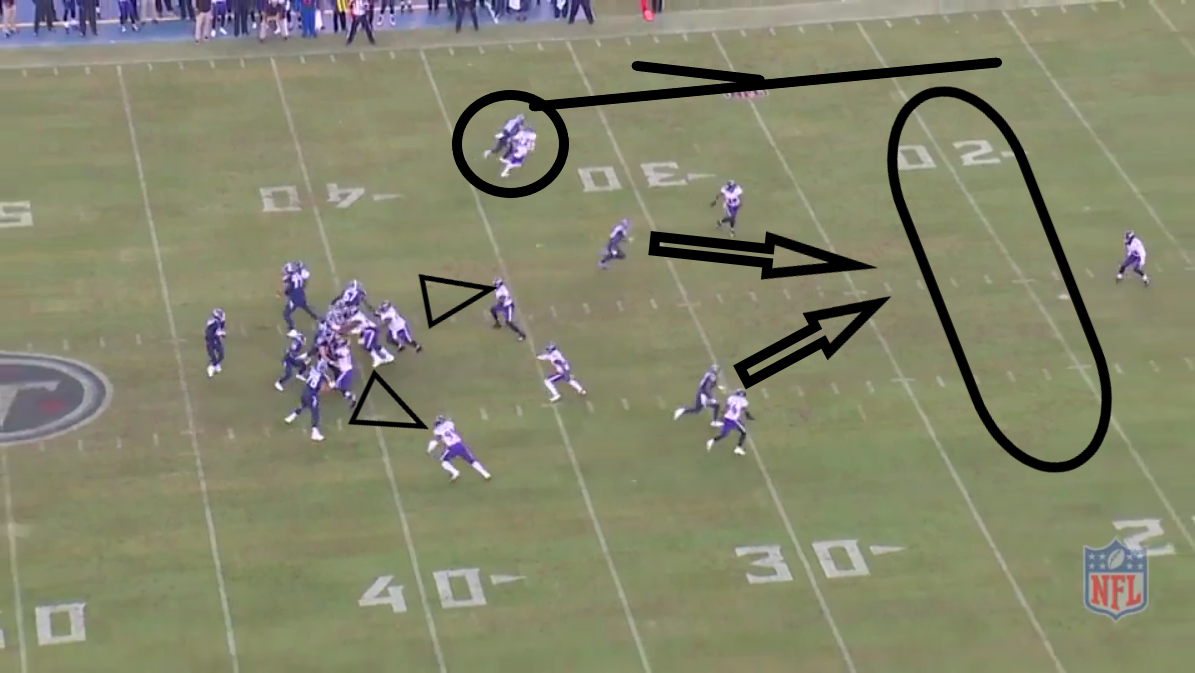
The WILL and SAM read their backs and prepare to execute a "green dog blitz." The Ravens blitz the MIKE, CJ Mosley, vacating the middle zone to any quick throws. This was a huge miss by Marcus Mariota, the Titans quarterback, because with the middle zone vacated, Brandon Carr was not yet fully in position to cover his man. Mariota needs to pull the trigger now or the inside funneling into Eric Weddle's zone will take away the possibility of any throws over the middle.
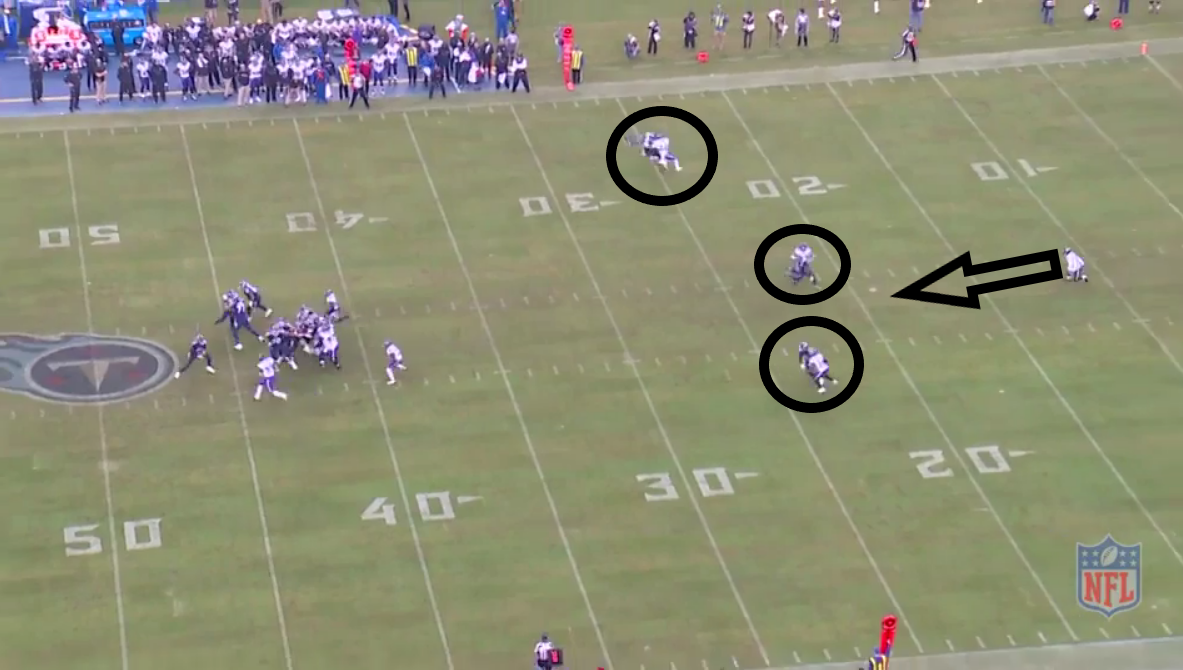
Mariota does not pull the trigger and instead, the Ravens defensive backs are able to close the gaps on their man. Weddle is now in perfect position to jump any routes over the middle of the field. The outside wide receiver tries to break his route to the inside, but he has to fight through Jimmy Smith who is in perfect position to take away any inside route. The result of the play was a sack by Patrick Onwuasor for a loss of seven yards.
Cover 1 vs the Plus SplitI just got finished saying that the goal of the Cover 1 defense was to funnel the receivers toward the inside of the field where the safety help is. The only reason the above play featured an outside release allowed was due to the bunch formation. This is a hard and fast rule, correct? Well, not exactly.
The exception to the rule comes when the wide receiver aligns in a "plus split." What this means is that the receiver aligns three to four yards outside the numbers, putting himself closer to the sideline than the middle of the field. In this scenario, the cornerback now has the option to align in press coverage with inside leverage to pinch the wide receiver the sideline and not allow an inside release. Remember, this limits the "easy" breaks to a fade or a comeback. Anything else will require that the wide receiver fight through the cornerback.
If the cornerback plays off man coverage against the plus split, however, he will still align with outside leverage and funnel his wide receiver to the inside of the field. He will take a flat footed approach to jump any of the three step routes. When this depth has been cleared, the cornerback will then backpedal with weaving to maintain a cushion and his outside leverage.
Let us take a look at a play from Week 3 against the Denver Broncos. The Broncos have the ball on 3rd and 2 from their own 45 yard line. Marlon Humphrey will align in press man coverage against the plus split.
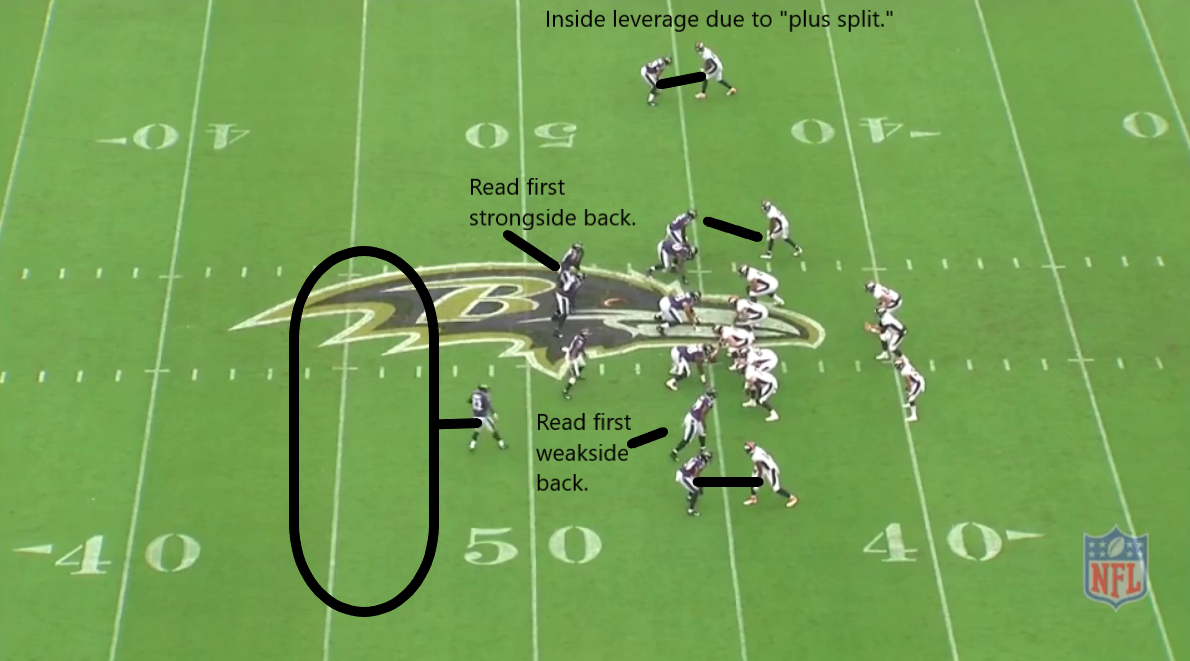
The wide receiver at the top of the screen aligns roughly three yards outside the bottom of the numbers. Marlon Humphrey will then align with inside leverage to force the receiver the sideline. All other cornerbacks or linebackers will funnel their man toward the middle of the field and Eric Weddle. There are two important things to note here. 1. The Ravens are taking advantage of positional flexibility offered by the 3-4 and adding a wrinkle. Instead of Kenny Young picking up the first weak-side back, Matthew Judon will. This allows Young to function as the MIKE linebacker with Mosley blitzing 2. With Marlon Humphrey pinching his receiver to the sideline, this effectively shrinks the field. Eric Weddle does not have to cover over the top from boundary to boundary and can instead effectively work from the top hash marks to the bottom of the numbers on the bottom side of the field.
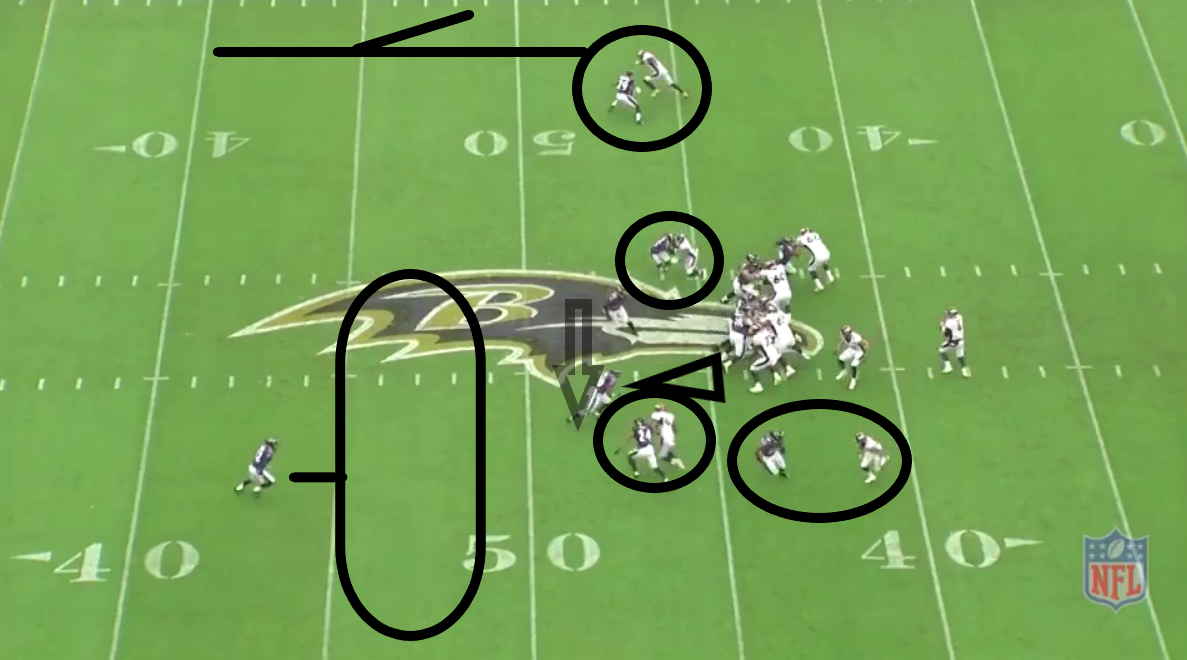
Young reads the second weak-side back, but the tight end sets up a pass protection stance, so Young has the green light to hunt for the quarterback. This leaves Tony Jefferson, who was acting as the strong-side linebacker, to flow across the formation and offer assistance in zone coverage underneath.
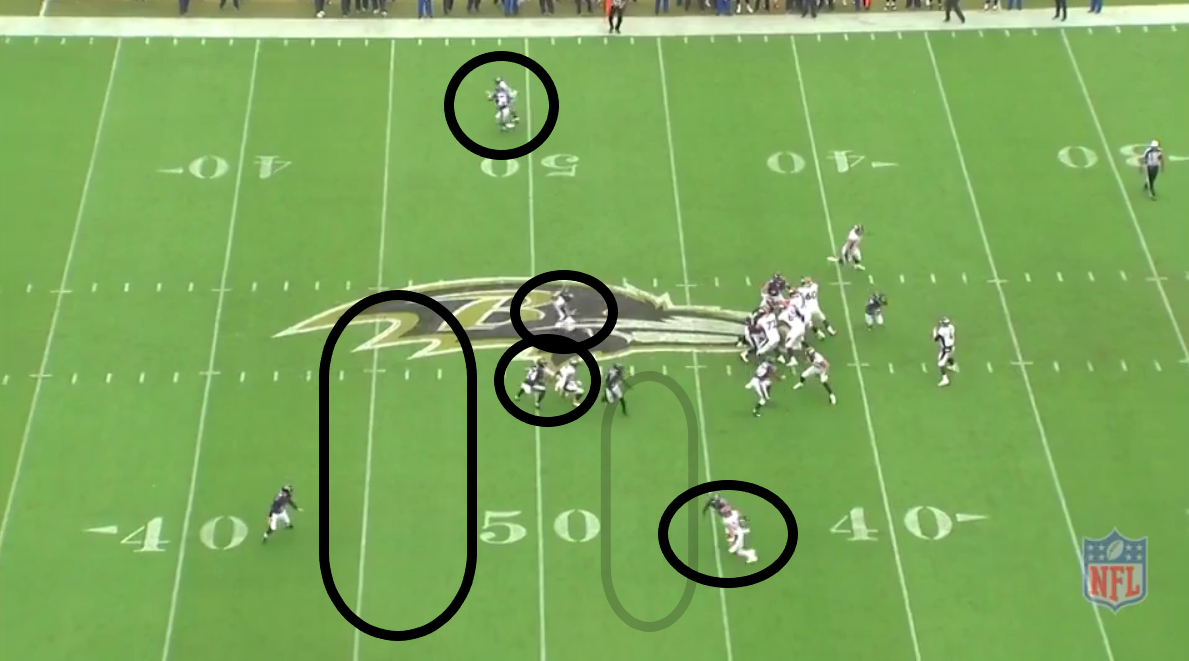
With a large amount of traffic and a high density of Ravens defenders, Case Keenum is left with no safe throws and is sacked for a loss of seven yards.
Please note: what is not shown is that pre-snap, the tight end was split out wide of the slot receiver. He was motioned inside, which caused Tony Jefferson to functionally align as a linebacker. Eric Weddle then dropped down to align Kenny Young more inside. This likely shifted the responsibilities. Originally, Jefferson would cover man to man with the tight end and Young would cover man to man with the running back, but the motion allowed Eric Weddle to change the responsibilities. Below is the original formation pre-snap.
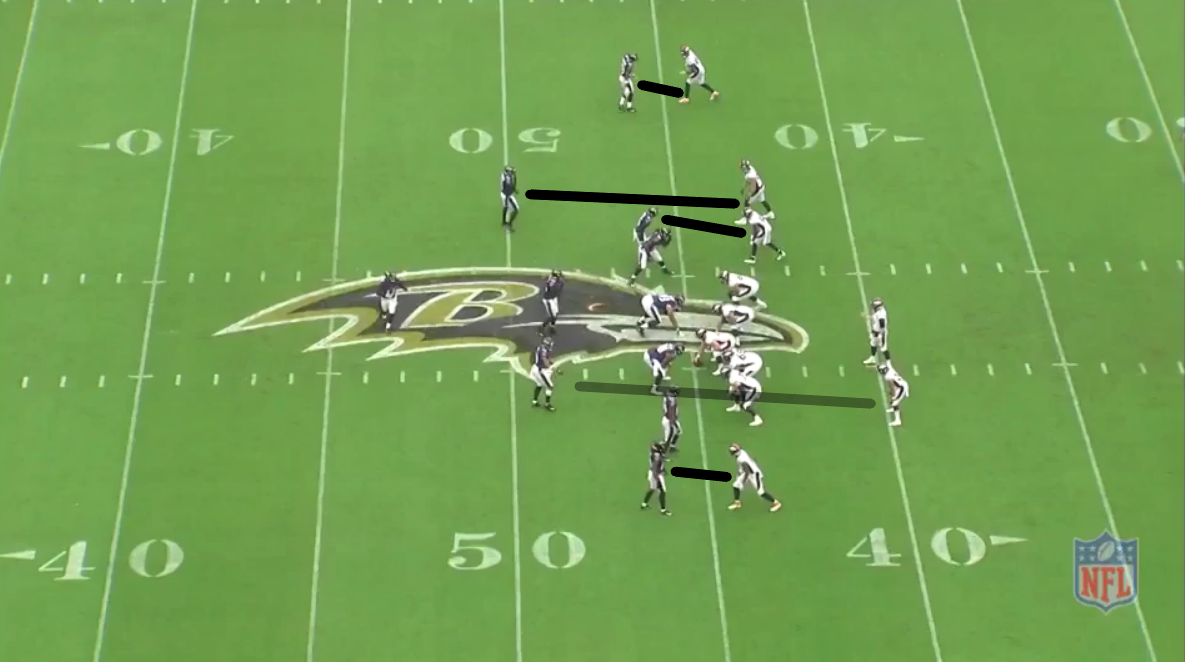
The above play is actually an excellent example of the fluidity of the linebackers. Due to the pre-snap motion, the defense shifted from Jefferson and Young in man to man coverage to the defense reading the post-snap action. Jefferson needed to read the strong-side back with Judon reading the weak-side back. Due to Mosley blitzing, Young functioned as the MIKE. This play also shows the importance of Eric Weddle to the defense. While Weddle has been oft criticized this year for being a step slower physically, he was right on time mentally for the defense.
The term "robber" is used as a term for the safety working down into a zone to "rob" the offense of the middle of the field. When a linebacker drops into a middle zone, this is called "RAT." So, Cover 1 RAT refers to the MIKE linebacker dropping into a middle zone and Cover 1 Robber refers to the safety dropping into a middle zone.
The biggest difference between a standard Cover 1 and a Cover 1 Robber is that the SAM linebacker will now be responsible for covering the tight end and the safety will take the job of covering the middle zone.
This next example is going to be painful, but please hang in there. The example is actually of the Jacksonville Jaguars defense against the Baltimore Ravens in Week 3 of the NFL season in London. The Ravens faced a 3rd and 12 from their own 24 yard line, trailing 10-0.
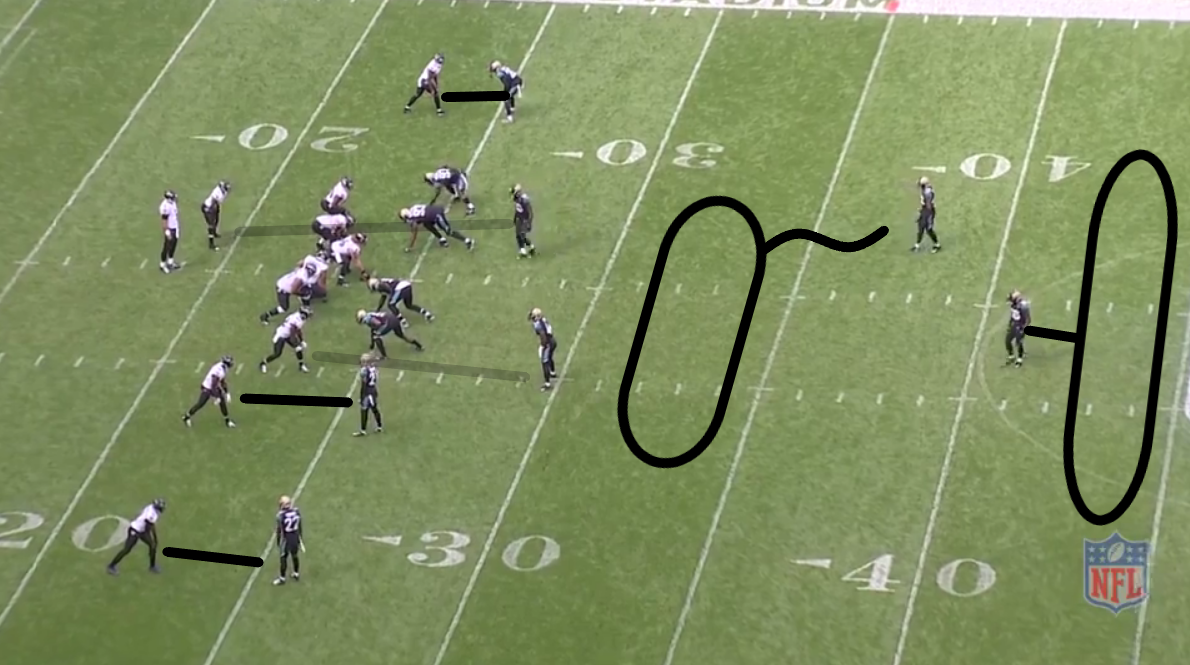
The initial pre-snap read would seem to suggest the Jacksonville Jaguars are playing Cover 2 man. However, just before the snap, Barry Church begins to creep slowly downhill.
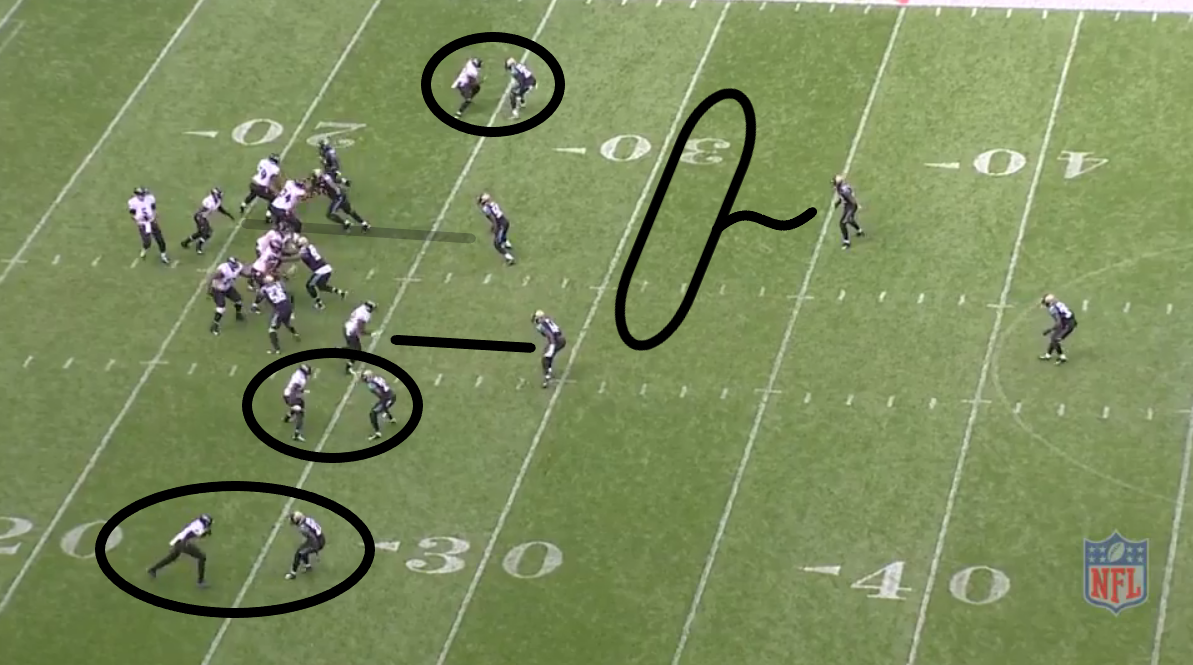
A.J. Bouye and Jalen Ramsey play with inside leverage to pinch their wide receivers to the sideline. Inside, Myles Jack and Aaron Colvin will work to funnel their men toward the middle of the field be playing with outside leverage. Telvin Smith will man up against the running back.
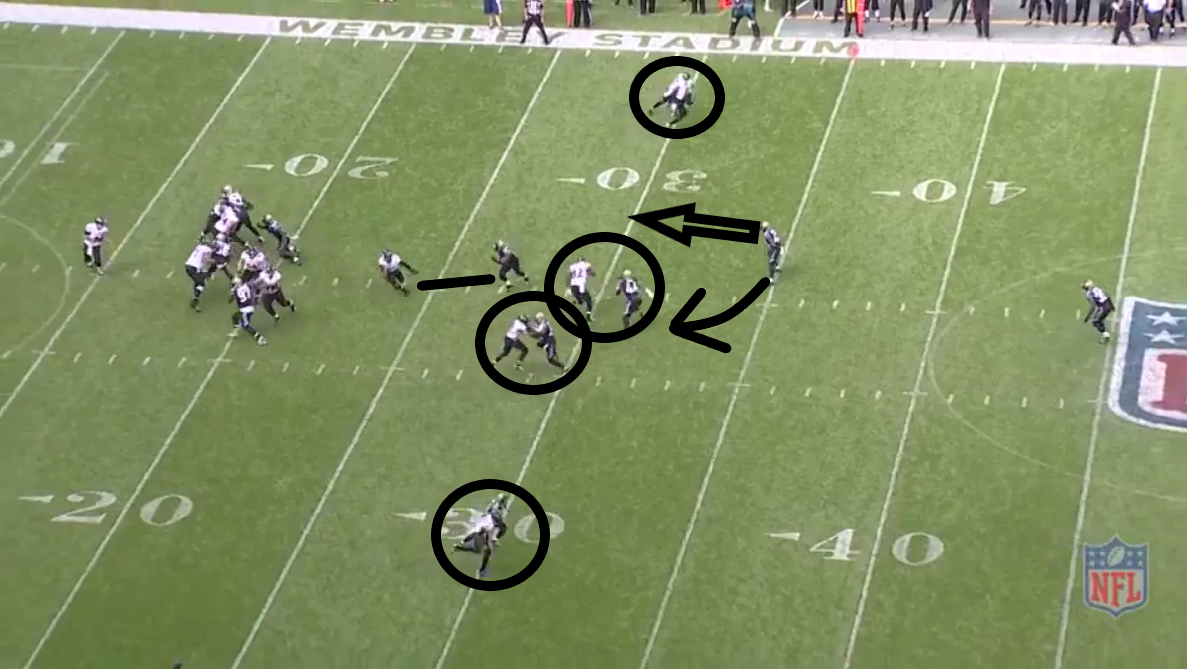
Barry Church is now in a position to jump a pass thrown to the crossing tight end or work around and jump any route thrown to the slot receiver.
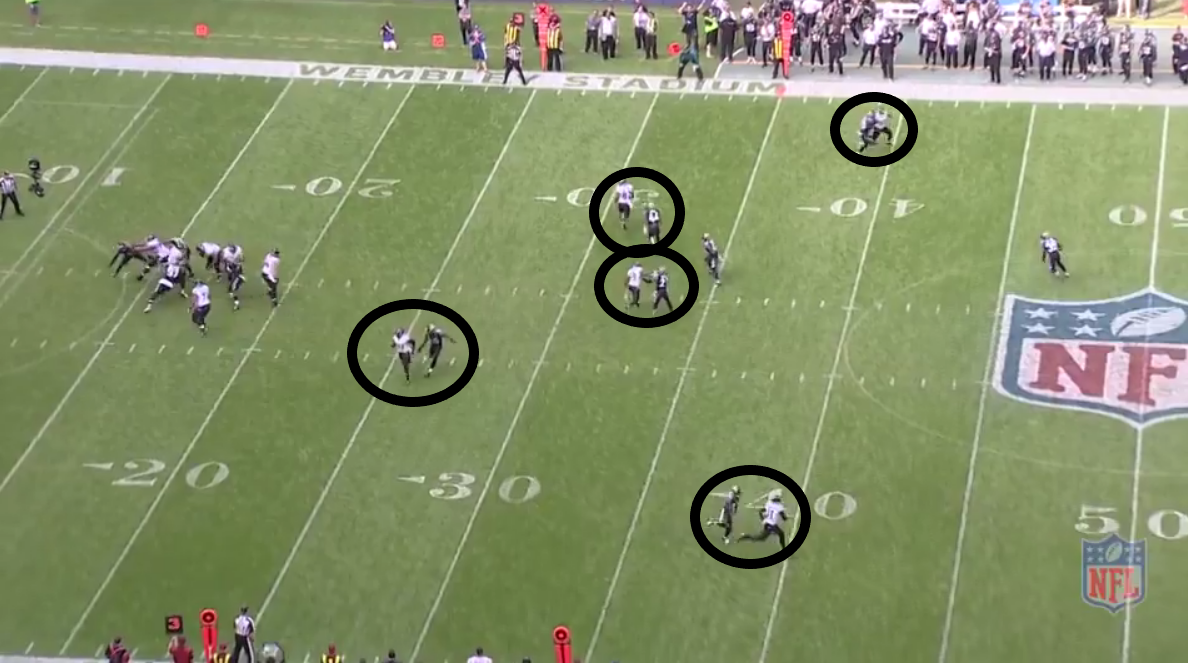
The result of the play is an easy sack by Calais Campbell for a loss of seven yards to force a Ravens punt.
Cover 1 Jump
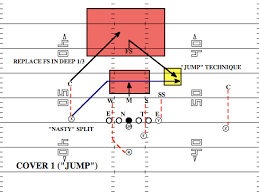
The above technique is called a "jump technique." This will rarely show up on game day, but it is at least worth mentioning because it is still apart of Cover 1.
When the wide out or slot receiver motions inside to reduce the split, the secondary may make the call to run the run a swap. Rather than having the cornerback run through the middle and fight through traffic, the cornerback will drop to cover the deep middle. The free safety, who has a much cleaner angle to the wide receiver, will then run downhill, targeting the inside shoulder of the receiver so as not to overshoot the play.
The free safety has an extremely difficult job as the center fielder of the defense, even more so in the Cover 1 where he is the only deep zone defender.
To start, the safety will read what is called a High-Hat, Low-Hat. What this means is that the safety will watch the offensive lineman's head. If the offensive lineman comes up, the free safety knows that the play is a pass play. If the offensive lineman's head stays down, the safety is going to make the assumption that it is a run play. The reason this is simply an assumption is that during play action pass plays, the offensive lineman will start with their head down, but then take a normal pass block set. To avoid overshooting downhill, the free safety will then work from the offensive lineman down to the quarterback and the running back. Once he confirms there was a hand off, he can work downhill.
However, that is not why a free safety makes the big money. The reason teams are willing to invest high draft choices into players like Minkah Fitzpatrick or put big money into players like Earl Thomas is the coverage abilities. A free safety must be extremely rangy to work sideline to sideline and play over the top of all routes. He is the last line of defense and the only defender working over the top in zone coverage.
Earl Thomas will be available in the offseason and there is a chance that Haha Clinton-Dix could walk from the Washington Redskins. The Ravens would have to at least take a sniff at these two due to their abilities to play single high.
The strength of the defense lies in the fact that every single eligible pass catching option is covered with man coverage and there is a free defender. The defense will always have a sixth option on defense who can either drop back into a zone or blitz. This also is a great coverage against a single deep route while also not conceding quick passes underneath.
As with any coverage, Cover 1 is not an infallible defensive call that will generate the desired results every single time. So, how do we attack Cover 1?
This coverage is very difficult to disguise pre-snap if the defense is not using a Robber call. Any pre-snap motions will immediately expose that the defense is playing Cover 1. From that point, the offense just simply has to know the weaknesses.
The main weakness lies in the fact that there is only one single deep defender. If a team sends two, three, or four vertical routes, there is only a single safety to help over the top of multiple deep defenders. The safety is then forced to make a choice as to who to cover.
Speaking of the safety, this coverage is also prone to the free safety being "looked off." That is to say that the quarterback will keep his eyes to one side of the field to bait the safety to cheat that way, then the quarterback will make a throw to the opposite side of the field.
Any time you are asking cornerbacks to play press man coverage, there are inherent challenges. It is very difficult to cover "mesh" routes where two receivers will both cross over the middle of the field. This asks cornerbacks to not only chase a man across the formation, but also work across the middle of the field through traffic.
Lastly, the running backs out to the flats can be an issue. By utilizing rub routes with the slot receiver or tight end, the offense can slow the pursuit of the linebacker and get the running back into space. At this point, the cornerback either has his back turned up-field or he is working to the middle of the field. This leaves the running back with a lot of open grass.
This is the defense for teams that want to be aggressive in their play calling while not giving up anything quick and easy, but it is not without its risks.
This is the second part in a multi-part series detailing coverages that are employed by NFL secondaries.
Part 1: Football for Dummies: Press Man Coverage vs Off Man Coverage
With that in mind, let us take a look at the Cover 1 defense, a defense that shows up quite commonly on Sundays, whether you realized it or not. It is an extremely basic defense that gets its name from the fact that there is one deep defender to cover the deep zone and plays man across the board on all receivers.
Cover 1 vs 21 Personnel
Please note: 21 personnel refers to two running backs, one tight end, and two receivers. The first number indicates the number of running backs and the second indicates the number of tight ends. Below is a play against the Tennessee Titans in Week 6. The Titans face 1st and 10 from the Ravens 37 yard line. The score is 14-0 with the Ravens leading 9:38 left in the second quarter.

The role of the linebackers is a little more fluid. The SAM linebacker, the linebacker playing on the strong-side of the formation where the tight end is, will pick up the first running back to run a route to his side of the formation. The WILL linebacker, the linebacker player on the weak-side of the formation where there is no tight end, will pick up the first back to run a route to his side of the formation. The MIKE, the middle linebacker, will then either drop into a zone to cover the middle of the field on all underneath and crossing routes or blitz.
But wait, what if both backs run a route to the strong-side or the weak-side of the formation? Then the SAM or WILL is left running across the formation, through traffic, and this creates problems, right? You would think so, but this is why I said the roles are slightly fluid. In actuality, what happens is that the MIKE linebacker will pick up the second back and the WILL or SAM, whoever did not have a route run to their side of the formation, will then play the role of dropping into the middle zone or blitz.
I have another question, though. What if neither or only one of the backs runs a route? What if one or both stay into block? Again, this is why I said the roles of the linebackers are a little fluid. The linebackers now have not one, but two choices. The linebackers can all drop into underneath routes and squat on any crossing quick inside breaking routes or the linebackers can execute what is called a "green dog blitz." A green dog blitz is when the linebackers read that their man is blocking and then blitz in response to having no man to cover. It is not a designed blitz, but rather a function of the play calling. Or, they could have the best of both worlds and squat on any crossing routes until they are sure that the receivers will not cross into their zone, then blitz.
Quite frankly, as long as every single offensive player that is running a route is covered, the linebackers offer a great deal of flexibility in how they are used.
Let us see how this play unfolds:

The Tennessee Titans send a wide receiver in motion. Brandon Carr follows across the formation. This instantly signals two things to the Titans. 1. The Ravens are playing man coverage and 2. Based on presnap alignment, the Ravens are playing Cover 1.

With the Titans settling into a stacked formation, Jimmy Smith motions with his arm that if the outside wide receiver releases outside, Smith will follow and pin him to the sideline. Pinning the wide receiver to the sideline gives the wide receiver access to only two "easy" routes: a fade route or a comeback. Any inside crossing route will require the wide receiver to fight through Smith and Smith will be in position to take away any inside routes.
But why switch who covers who? The stacked and bunch formations are designed to beat man coverage by creating space and favorable angles. Not swapping wide receivers can lead to the point man, the inside wide receiver, running a pick/rub route with the trail man, the outside wide receiver, running an option route designed to take advantage of the space created by the point man. By switching, the Ravens cornerbacks avoid this issue entirely.

The WILL and SAM read their backs and prepare to execute a "green dog blitz." The Ravens blitz the MIKE, CJ Mosley, vacating the middle zone to any quick throws. This was a huge miss by Marcus Mariota, the Titans quarterback, because with the middle zone vacated, Brandon Carr was not yet fully in position to cover his man. Mariota needs to pull the trigger now or the inside funneling into Eric Weddle's zone will take away the possibility of any throws over the middle.

Mariota does not pull the trigger and instead, the Ravens defensive backs are able to close the gaps on their man. Weddle is now in perfect position to jump any routes over the middle of the field. The outside wide receiver tries to break his route to the inside, but he has to fight through Jimmy Smith who is in perfect position to take away any inside route. The result of the play was a sack by Patrick Onwuasor for a loss of seven yards.
Cover 1 vs the Plus Split
The exception to the rule comes when the wide receiver aligns in a "plus split." What this means is that the receiver aligns three to four yards outside the numbers, putting himself closer to the sideline than the middle of the field. In this scenario, the cornerback now has the option to align in press coverage with inside leverage to pinch the wide receiver the sideline and not allow an inside release. Remember, this limits the "easy" breaks to a fade or a comeback. Anything else will require that the wide receiver fight through the cornerback.
If the cornerback plays off man coverage against the plus split, however, he will still align with outside leverage and funnel his wide receiver to the inside of the field. He will take a flat footed approach to jump any of the three step routes. When this depth has been cleared, the cornerback will then backpedal with weaving to maintain a cushion and his outside leverage.
Let us take a look at a play from Week 3 against the Denver Broncos. The Broncos have the ball on 3rd and 2 from their own 45 yard line. Marlon Humphrey will align in press man coverage against the plus split.

The wide receiver at the top of the screen aligns roughly three yards outside the bottom of the numbers. Marlon Humphrey will then align with inside leverage to force the receiver the sideline. All other cornerbacks or linebackers will funnel their man toward the middle of the field and Eric Weddle. There are two important things to note here. 1. The Ravens are taking advantage of positional flexibility offered by the 3-4 and adding a wrinkle. Instead of Kenny Young picking up the first weak-side back, Matthew Judon will. This allows Young to function as the MIKE linebacker with Mosley blitzing 2. With Marlon Humphrey pinching his receiver to the sideline, this effectively shrinks the field. Eric Weddle does not have to cover over the top from boundary to boundary and can instead effectively work from the top hash marks to the bottom of the numbers on the bottom side of the field.

Young reads the second weak-side back, but the tight end sets up a pass protection stance, so Young has the green light to hunt for the quarterback. This leaves Tony Jefferson, who was acting as the strong-side linebacker, to flow across the formation and offer assistance in zone coverage underneath.

With a large amount of traffic and a high density of Ravens defenders, Case Keenum is left with no safe throws and is sacked for a loss of seven yards.

Cover 1 Robber
The term "robber" is used very broadly when discussed in relation to Cover 1. Many people will use "robber" to simply mean any defender that drops into a zone over the middle of the field to "rob" the offense of short routes. However, I do not like this broad term being used.The term "robber" is used as a term for the safety working down into a zone to "rob" the offense of the middle of the field. When a linebacker drops into a middle zone, this is called "RAT." So, Cover 1 RAT refers to the MIKE linebacker dropping into a middle zone and Cover 1 Robber refers to the safety dropping into a middle zone.
The biggest difference between a standard Cover 1 and a Cover 1 Robber is that the SAM linebacker will now be responsible for covering the tight end and the safety will take the job of covering the middle zone.
This next example is going to be painful, but please hang in there. The example is actually of the Jacksonville Jaguars defense against the Baltimore Ravens in Week 3 of the NFL season in London. The Ravens faced a 3rd and 12 from their own 24 yard line, trailing 10-0.

The initial pre-snap read would seem to suggest the Jacksonville Jaguars are playing Cover 2 man. However, just before the snap, Barry Church begins to creep slowly downhill.

A.J. Bouye and Jalen Ramsey play with inside leverage to pinch their wide receivers to the sideline. Inside, Myles Jack and Aaron Colvin will work to funnel their men toward the middle of the field be playing with outside leverage. Telvin Smith will man up against the running back.

Barry Church is now in a position to jump a pass thrown to the crossing tight end or work around and jump any route thrown to the slot receiver.

The result of the play is an easy sack by Calais Campbell for a loss of seven yards to force a Ravens punt.
Cover 1 Jump

When the wide out or slot receiver motions inside to reduce the split, the secondary may make the call to run the run a swap. Rather than having the cornerback run through the middle and fight through traffic, the cornerback will drop to cover the deep middle. The free safety, who has a much cleaner angle to the wide receiver, will then run downhill, targeting the inside shoulder of the receiver so as not to overshoot the play.
The Most Important Man
The most important man in the single high safety coverages is... the free safety, as if that was a surprise from the namesake.The free safety has an extremely difficult job as the center fielder of the defense, even more so in the Cover 1 where he is the only deep zone defender.
To start, the safety will read what is called a High-Hat, Low-Hat. What this means is that the safety will watch the offensive lineman's head. If the offensive lineman comes up, the free safety knows that the play is a pass play. If the offensive lineman's head stays down, the safety is going to make the assumption that it is a run play. The reason this is simply an assumption is that during play action pass plays, the offensive lineman will start with their head down, but then take a normal pass block set. To avoid overshooting downhill, the free safety will then work from the offensive lineman down to the quarterback and the running back. Once he confirms there was a hand off, he can work downhill.
However, that is not why a free safety makes the big money. The reason teams are willing to invest high draft choices into players like Minkah Fitzpatrick or put big money into players like Earl Thomas is the coverage abilities. A free safety must be extremely rangy to work sideline to sideline and play over the top of all routes. He is the last line of defense and the only defender working over the top in zone coverage.
Earl Thomas will be available in the offseason and there is a chance that Haha Clinton-Dix could walk from the Washington Redskins. The Ravens would have to at least take a sniff at these two due to their abilities to play single high.
The Strengths and Weaknesses of Cover 1
The Cover 1 remains a popular man coverage option for a variety of reasons, starting with the ability of the defense to defend the run. With 22 personnel on offense, the defense will have a 9 man box. With 21 personnel, the defense will have eight men in the box. With 11 personnel, the defense will still have a seven man box. The numbers are always favorable for the defense against the run, especially if the defensive backs are strong in run support. But we play this coverage to cover the pass, so where are the strengths there?The strength of the defense lies in the fact that every single eligible pass catching option is covered with man coverage and there is a free defender. The defense will always have a sixth option on defense who can either drop back into a zone or blitz. This also is a great coverage against a single deep route while also not conceding quick passes underneath.
As with any coverage, Cover 1 is not an infallible defensive call that will generate the desired results every single time. So, how do we attack Cover 1?
This coverage is very difficult to disguise pre-snap if the defense is not using a Robber call. Any pre-snap motions will immediately expose that the defense is playing Cover 1. From that point, the offense just simply has to know the weaknesses.
The main weakness lies in the fact that there is only one single deep defender. If a team sends two, three, or four vertical routes, there is only a single safety to help over the top of multiple deep defenders. The safety is then forced to make a choice as to who to cover.
Speaking of the safety, this coverage is also prone to the free safety being "looked off." That is to say that the quarterback will keep his eyes to one side of the field to bait the safety to cheat that way, then the quarterback will make a throw to the opposite side of the field.
Any time you are asking cornerbacks to play press man coverage, there are inherent challenges. It is very difficult to cover "mesh" routes where two receivers will both cross over the middle of the field. This asks cornerbacks to not only chase a man across the formation, but also work across the middle of the field through traffic.
Lastly, the running backs out to the flats can be an issue. By utilizing rub routes with the slot receiver or tight end, the offense can slow the pursuit of the linebacker and get the running back into space. At this point, the cornerback either has his back turned up-field or he is working to the middle of the field. This leaves the running back with a lot of open grass.
This is the defense for teams that want to be aggressive in their play calling while not giving up anything quick and easy, but it is not without its risks.
This is the second part in a multi-part series detailing coverages that are employed by NFL secondaries.
Part 1: Football for Dummies: Press Man Coverage vs Off Man Coverage
Attachments
Last edited:


